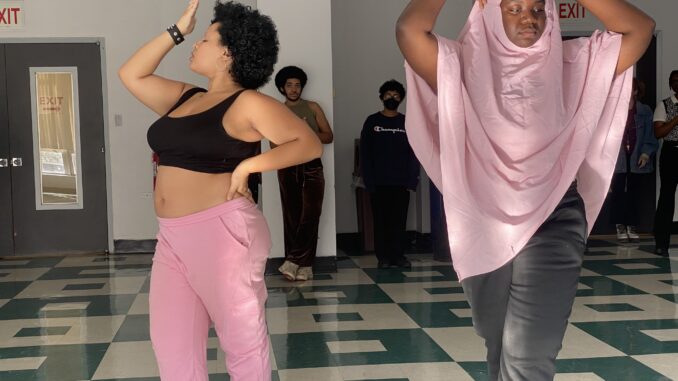
By Giovanni M. Ravalli, LGBTQ+ Correspondent
In preparation for the first CUNY-wide Vogue Ball, the LGBTQ+ Resource Center at Brooklyn College held a Vogue workshop on Nov. 12.
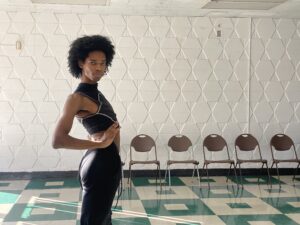
Skilled instructors came to BC to prepare students for the Ball, which is scheduled for Dec. 12 from 5 – 8 p.m. in BC’s Gold & Maroon Room on the sixth floor of the Student Center. To the instructors, it was an opportunity to teach the community the history and origins of voguing, which originated in ballroom culture: underground dance competitions held among the queer community.
“The purpose was to introduce the students and CUNY community to the ballroom culture that exists in New York,” Felix Luar, a vogue instructor, told The Vanguard. “It’s a very thriving part of the queer community, so we’re hoping to expand it to reach the students where they can access creative energy and free themselves.”
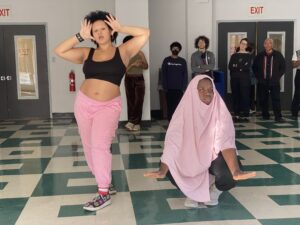
The “mainstream” scene, also known as the “Major Scene,” is the most serious and prestigious scene, which is highly competitive. In ballroom culture, houses–chosen families made up of friends–compete against one another. According to PBS, houses historically serve as alternative families to LGBTQ+ people in need of safe spaces. They typically follow a family structure led by a “mother” or “father” who are usually older and guide and support their “children.” Functionally under a chosen family, each member of a house competes under the same name. Most houses are recognized nationally as well as internationally and often partner with organizations.
The “Kiki” scene imitates the major scene but is oriented around friendly and fun competition. Like the mainstream scene, it is also focused on community. It is usually a scene for youth in preparation and practice for the mainstream scene.
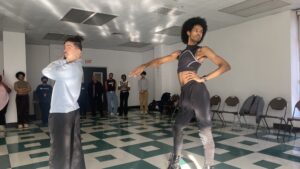
“The Kiki scene was started for queer youth, and it’s for people to express themselves without judgment, without pressure as much as the main scene is,” instructor for the House of Louboutin, Widow James, told The Vanguard. “The main scene is usually more traveling, it costs more, a little bit of a higher stakes type of thing. So usually younger people start in the Kiki scene to get their bearings within the ballroom scene itself.”
Attendees were able to learn more about voguing and have fun while practicing new skills. They got to learn the basics, such as the categories of the ballroom scene: face, runway, realness, fashion, and bazaar, among others. There are several styles and techniques of vogue. Waacking and tutting, for example, are two types of voguing focused on hand and arm movements.
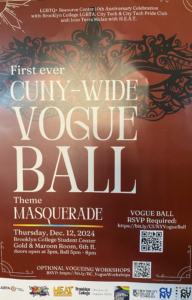
“It was really very exhilarating. I really enjoyed it and I didn’t know what I was fully going to get into, but I just knew I wanted to enhance my skills in voguing,” said Alexander Pena, a junior majoring in acting at BC. “I have a friend of mine who’s very into waacking, and they know I’m a dancer and they saw that I could have that dancer potential in learning. Waacking and tutting is a type of hands voguing stylistically.”
The first-ever CUNY-Wide Vogue Ball, as part of the LGBTQ+ Resource Center’s 10th Anniversary Celebration, is co-sponsored by SUNY Downstate Medical Center’s HEAT (Health Education Alternatives for Teens), City Tech, and student clubs from BC and CUNY. It will immerse participants in the vibrant world of ballroom culture, with the theme for the event as “Masquerade Ball.” As part of its preparation, the Center’s leaders wanted to also advocate about the history of the marginalized communities that make up this genre of dance.

“The workshops were given by members of the Ballroom Scene in New York City, including Terra Mulan, Widow James, Felix Laur, and Jordyn. Participants had the opportunity to learn about the history of ballroom culture, as a safe haven for Black and Brown gay folks in the city in the early 1970s and 80s when it wasn’t safe to be out,” said Kelly Spivey, director of the LGBTQ+ Resource Center.
While there is no official dress code, gowns, suits, and more are encouraged along with masks. Expect to see fierce competition in categories such as Vogue, Runway, Face, etc. where CUNY students will showcase their creativity and self-expression. Students across CUNY are encouraged to start their own Vogue Houses and compete in these categories. BC’s official “House of Koi,” named after the Koi pond unique to BC, will be among the many CUNY houses competing in the Vogue Ball come December.
This ball is not only a celebration of queer culture, but a reflection of the resilience, history, and community found within the ballroom scene. A resource fair will precede the ball, offering educational materials, free STD/STI testing, and more.
“I’m part of the House of Koi so I definitely will be involved with that and see where that takes me,” said Pena. “There’s a lot of techniques and, of course, people have done it for years so it can get very competitive. But at the end of the day, it’s just expressing yourself.”
Students interested in attending the CUNY-Wide Vogue Ball can visit https://www.brooklyn.edu/event/cuny-wide-vogue-ball/ and for more information visit the LGBTQ+ Resource Center’s website https://www.brooklyn.edu/lgbtq-center/ or their Instagram @lgbtqcenter_bc
